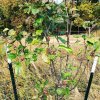blueKYstream
5 year old buck +
I bought 16 pears last year from The Wildlife Group. A couple died and I replaced them when Walmart had their remaining stock on clearance. I planted one that is supposed to be a Kieffer Pear. That's what the tag said anyways. The clearance sticker slapped on it by Walmart said Bartlett Pear. I'm not sure which it is, but last year I noticed spots on it and then it would drop leaves. It did this two or three times. I thought maybe it was the stress of planting it in mid-June.
As an added precaution, I sprayed it last week with Garden Safe Fungicide when it first started leafing out. Today, I went to check on it and, sure enough, it's back. My questions are: Is this black spot or some other disease? Will it come back every year? Is there something better to treat with? A strict regimen of reapplying every 7-10 days is not going to be possible, especially as the tree gets larger. I'm hoping I won't need to topwork it to another variety, but I'm curious what your thoughts are.




As an added precaution, I sprayed it last week with Garden Safe Fungicide when it first started leafing out. Today, I went to check on it and, sure enough, it's back. My questions are: Is this black spot or some other disease? Will it come back every year? Is there something better to treat with? A strict regimen of reapplying every 7-10 days is not going to be possible, especially as the tree gets larger. I'm hoping I won't need to topwork it to another variety, but I'm curious what your thoughts are.


















